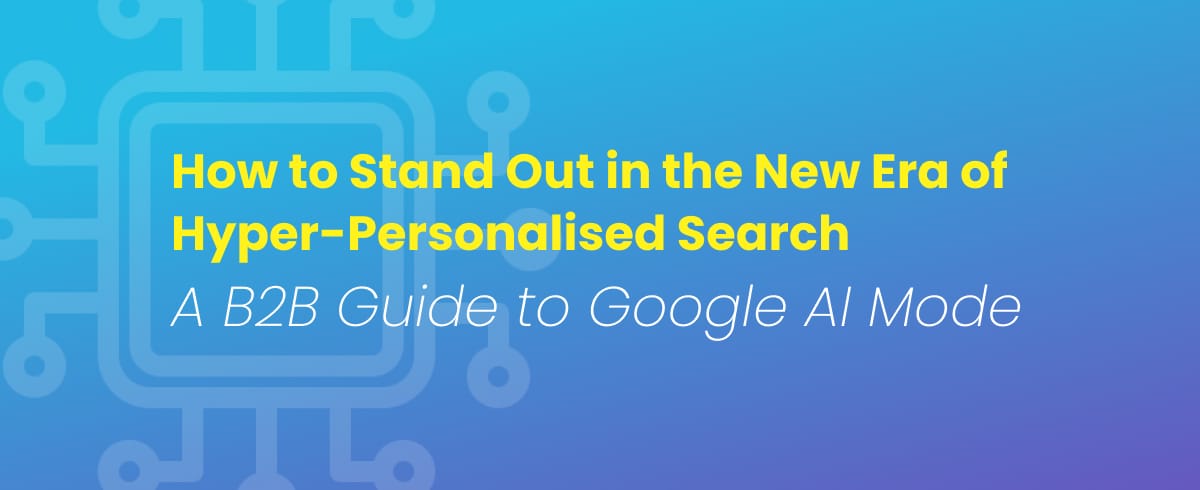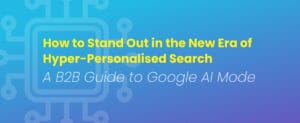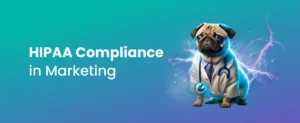Google has officially redrawn the map. With the launch of AI Mode powered by Gemini 2.5, Search is no longer a list of links or even a helpful summary. It’s a highly personalised digital assistant that is designed to be fine-tuned to each user’s habits, preferences, schedule, and even their inbox. For B2B marketers, everything is about to change.
Here’s how to show up in the SERPS when it matters most, and stand out to your target audience when nobody else does.
Intent, Intent, Intent
With the rise of AI overviews, traditional search is no longer about chasing static keywords. It has shifted to be dynamic, contextual, and driven by real-time signals users send through their daily interactions with the internet. AI Mode breaks down queries into subtopics and runs hundreds of simultaneous searches to understand what someone’s intent is, what they actually mean when they type their queries into the search bar.
What this means for marketers is that the old way of compiling lists of keywords to target, hoping to rank for “cloud security platform,” will no longer get your product in front of your target audience. What you need to start ranking for are niche, spoken-word queries like “my CFO wants audit logs we don’t have” or “What is an ISO compliance checklist for SaaS?”. Think task-level, job-to-be-done, and emotional-need-focused intent.
Action you can take today:
- Audit your existing content or pending content plans for intent layers that you know your target audience experiences (think pain, urgency, research, evaluation, implementation).
- As we watch the funnel stages collapse, start to map search behaviours to buying stages or moments instead.
Data Has Never Been So Important
AI Mode is pulling in signals from users’ email, calendar, YouTube, Maps and more. Every click, scroll, and micro-action is feeding its machine and teaching it how to offer responses that are highly-personalised to a searchers immediate need.
In response, B2B marketers need to build their own data depth. AI is only as good as what it knows about your audience, and if you’re relying on third-party targeting or assumptions from last year’s personas, you’re already behind.
Leverage what you know about the pain points your customer faces, and use it to generate extremely specific content that solves their challenges and meets their queries where they are. Aim to become a hyper-niche expert in your space, as authority and E-E-A-T signals could differentiate you from your competition.
Action you can take today:
- Run proprietary audience research: polls, interviews, feedback loops.
- Use zero- and first-party data to map content to context: job title + behaviour + channel = real insight.
- Feed this back into your marketing and content strategy
Put Your Persona Front and Centre
Traditional personas are now too broad. AI Mode is going to treat every user as unique. That means segmentation must go deeper: by motivation, by emotional state, and by timing at the bare minimum.
A B2B buyer researching ESG software isn’t just a sustainability officer. They might be under board pressure, juggling compliance audits, or building a case to overhaul legacy tools. AI Mode will pick up on all of that, and so should your content.
Action you can take today:
- Personalise messaging by use case, not just sector.
- Consider mood, mission, and moment in your segmentation.
Prepare for Micro-Moments
Decision-making is no longer linear. With AI Mode, anyone can enter the consideration or conversion stage instantly based on calendar prompts, Slack messages, or a stray YouTube video.
Google calls this “agentic AI”: performing the thinking and the doing. Need tickets booked? Dinner reserved? Tools shortlisted for a team pitch? It’s all happening within a single search moment.
Action you can take today:
- Design content for real-world triggers: QBR season, funding rounds, team hires.
- Optimise for always-on visibility, not just top of funnel, which is entering a state of collapse, but rather for top of mind.
Optimise for the Why, Not the What
A CTO doesn’t Google “cybersecurity platform”. They Google “why does our vendor keep failing pen tests?”. AI Mode answers questions based on emotional cues, not just product matches.
Because of this change of direction, your content now needs to dig deeper into the root motivations behind your ideal customer’s search queries.
Action you can take today:
- Rewrite meta titles, intros, and summaries to reflect the pain behind the problem.
- Include human language and FAQs, not just product specs.
Discovery Tactics Outside of Google Will Be Your New Best Friend
If a user hasn’t signalled interest in your category, AI Mode might not show your brand at all. You’re invisible unless you’re already relevant.
That means discovery can’t just be organic anymore. You have to earn relevance before someone searches.
Action you can take today:
- Seed high-quality content in communities, which are becoming more relevant than ever (Reddit, Quora, LinkedIn Groups).
- Optimise for YouTube Shorts, TikTok (yes, even in B2B), and newsletter mentions, use every platform and channel you can.
SERP Real Estate Is a Bun Fight
AI Overviews compress entire journeys into one answer box. Clicks are shrinking, and the share of visibility matters more than ever.
It’s no longer about just trying to rank. Instead, the goal posts have shifted; you now want to be the source that Google summarises.
Action you can take today:
- Use structured data, direct answer formatting, and schema markup.
- Monitor AI Overviews and reverse-engineer which content types are getting quoted.
You’re Now Ranking for People, Not Search Terms
We’ve said it before, but we’ll say it again: the reign of keyword density has ended. AI Mode is now going to be matching content to individual identities, informed by their behaviour, purchase history, and content consumption.
That means two people searching the same phrase might get different brands shown to them, or none at all, depending on their personal search information and Google data.
Action you can take today
- Build topical authority around real user journeys, what we like to call “moments”, not just keywords.
- Include social proof, real voices, and multi-format experiences. Reviews and forums matter.
Diversify Your Entry Points
Search is no longer Google-only. The new SEO battlefield includes TikTok, YouTube, Pinterest, and forums. Even ChatGPT and Gemini are becoming discovery surfaces.
Action you can take today
- Syndicate and optimise content across short-form video, podcasts, and newsletters where applicable.
- Use creators, partners, and employees to expand brand reach and inject relevance into your content.
Tap Into Culture, Behaviour and Emotion (Yes, Even in B2B)
Search is getting emotional. AI Mode detects for signs of stress, frustration, joy, and urgency. B2B brands that stay rigid, overly technical, or impersonal will get filtered out of an AI overview response, which is more human-centric than ever.
Action you can take today:
- Use tone, narrative, and relevance to emotionally connect with buyers, understand their emotional search state, and match your content to solve for their problems and queries.
- Respond to cultural signals and seasonal triggers within your niche.
Our Closing Statement: You’re No Longer Competing for Clicks. You’re Competing for Relevance
In this AI-first era, Google is shaping the user journey. But that doesn’t mean B2B marketers are powerless. It does mean that the brief has changed: from chasing search terms to earning trust, from producing content to training algorithms on your content relevance and audience needs.
In B2B, the winners will be the brands that show up with empathy, authority, and timing. Not just once, but consistently, across every possible channel and online conversation.
Google is listening. Become a brand that’s worth hearing.





















